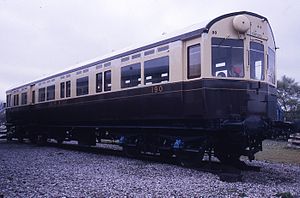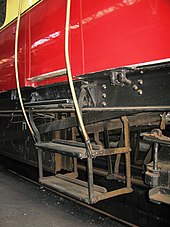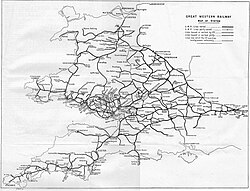
The Great Western Railway (GWR) was a British railway company that linked London with the southwest, west and West Midlands of England and most of Wales. It was founded in 1833, received its enabling act of Parliament on 31 August 1835 and ran its first trains in 1838 with the initial route completed between London and Bristol in 1841. It was engineered by Isambard Kingdom Brunel, who chose a broad gauge of 7 ft —later slightly widened to 7 ft 1⁄4 in —but, from 1854, a series of amalgamations saw it also operate 4 ft 8+1⁄2 in standard-gauge trains; the last broad-gauge services were operated in 1892.
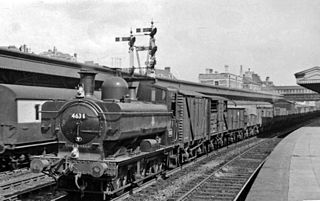
The GWR 5700 Class is a class of 0-6-0PT steam locomotive built by the Great Western Railway (GWR) and British Railways (BR) between 1929 and 1950. With 863 built, they were the most prolific class of the GWR, and one of the most numerous classes of British steam locomotive.

The GWR 1400 Class is a class of steam locomotive designed by the Great Western Railway for branch line passenger work. It was originally classified as the 4800 Class when introduced in 1932, and renumbered in 1946.

The Great Western Railway (GWR) 5400 Class was a class of 0-6-0 pannier tank steam locomotive. They were similar in appearance to many other GWR tank engines but smaller than the ubiquitous GWR 5700 Class.

The Midland Railway (MR) 2441 Class was a class of 0-6-0T steam locomotives. They were introduced by Samuel Johnson in 1899, originally with round-topped fireboxes. Henry Fowler later rebuilt them with Belpaire fireboxes. They were given the power classification 3F. The LMS Fowler Class 3F of 1924 was based on this design.

Charles Benjamin Collett was Chief Mechanical Engineer of the Great Western Railway from 1922 to 1941. He designed the GWR's 4-6-0 Castle and King Class express passenger locomotives.
Push–pull is a configuration for locomotive-hauled trains, allowing them to be driven from either end of the train, whether having a locomotive at each end or not.
The Gorgon class were six 4-4-0ST broad gauge locomotives operated on the South Devon Railway, Cornwall Railway and West Cornwall Railway. They were designed for passenger trains on this steep and sharply curved line but were also used on goods trains when required.
The four Tornado class locomotives were 0-6-0ST broad gauge locomotives operated on the South Devon Railway and associated railways. They were designed for goods trains but were also used on passenger trains when required.
The Lambourn Valley Railway (LVR) was a branch railway line running from the town of Newbury, Berkshire north-west to the village of Lambourn. It was opened in 1898. Fulfilling a local need, it was in financial difficulties throughout its independent life and was sold to the Great Western Railway (GWR) in 1905.
Railmotor is a term used in the United Kingdom and elsewhere for a railway lightweight railcar, usually consisting of a railway carriage with a steam traction unit, or a diesel or petrol engine, integrated into it.

The GWR 2021 Class was a class of 140 0-6-0ST steam locomotives. They were built at the Wolverhampton railway works of the Great Western Railway between 1897 and 1905. 1897 was the very year of George Armstrong's retirement, so it is uncertain if the design should be attributed to him or to his superior at Swindon, William Dean.

The 517 Class were small 0-4-2T tank engines designed by George Armstrong for local passenger work on the Great Western Railway. They were built at Wolverhampton Works and were outshopped between 1868 and 1885. They were built in thirteen lots commencing with 517–528 and ending with 1477–1488 in 1884–1885.
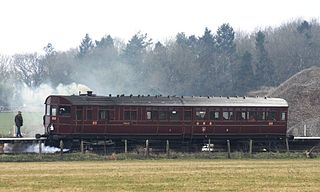
The steam rail motors (SRM) were self-propelled carriages operated by the Great Western Railway in England and Wales from 1903 to 1935. They incorporated a steam locomotive within the body of the carriage.
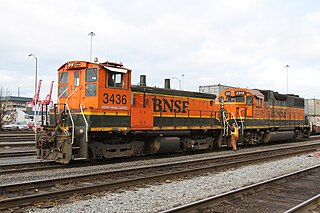
A remote control locomotive is a railway locomotive that can be operated with a remote control. It differs from a conventional locomotive in that a remote control system has been installed in one or more locomotives within the consist, which uses either a mechanical or radio transmitter and receiver system. The locomotive is operated by a person not physically at the controls within the locomotive cab. They have been in use for many years in the railroad industry, including industrial applications such as bulk material load-out, manufacturing, process and industrial switching. The systems are designed to be fail-safe so that if communication is lost the locomotive is brought to a stop automatically.

The Autotrain was a type of passenger train used in the early 20th century, where the steam locomotive could be remotely controlled from the rear of the train. This meant that the engine would not have to run-around at the end of a journey before returning. These trains were also known as motor trains or railmotors at the time, but the term railmotor is now used to refer to trains where the steam engine was integrated into the coach.
Paulton Halt railway station was on the Camerton branch of the Great Western Railway in Somerset, England. It was in use from 1914 until 1925, however it was closed for 8½ of these 12 years due to World War I.

Cinderford New railway station was a railway station that was opened by the former Severn and Wye Railway to serve the mining town of Cinderford.

Diesel multiple units and railcars are trains, usually with passenger accommodation, that do not require a locomotive. Railcars can be single cars, while in multiple units cars are marshalled together with a driving position either end. As of December 2010, 23 percent of the rail passenger cars used on Network Rail are part of a diesel multiple unit.

A steam railcar is a rail vehicle that does not require a locomotive as it contains its own steam engine. The first steam railcar was an experimental unit designed and built in 1847 by James Samuel and William Bridges Adams. In 1848, they made the Fairfield steam carriage that they sold to the Bristol and Exeter Railway, who used it for two years on a branch line.
